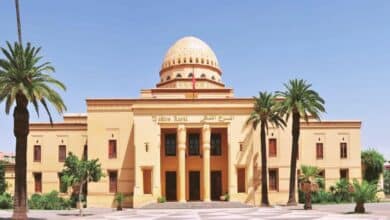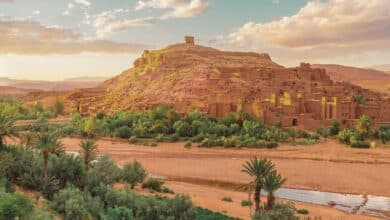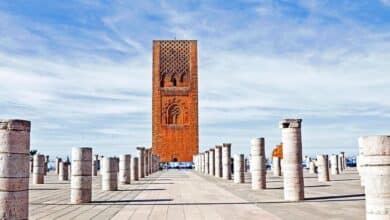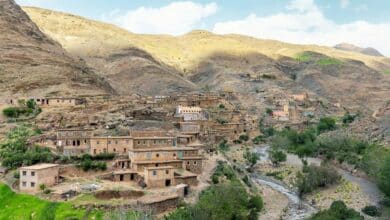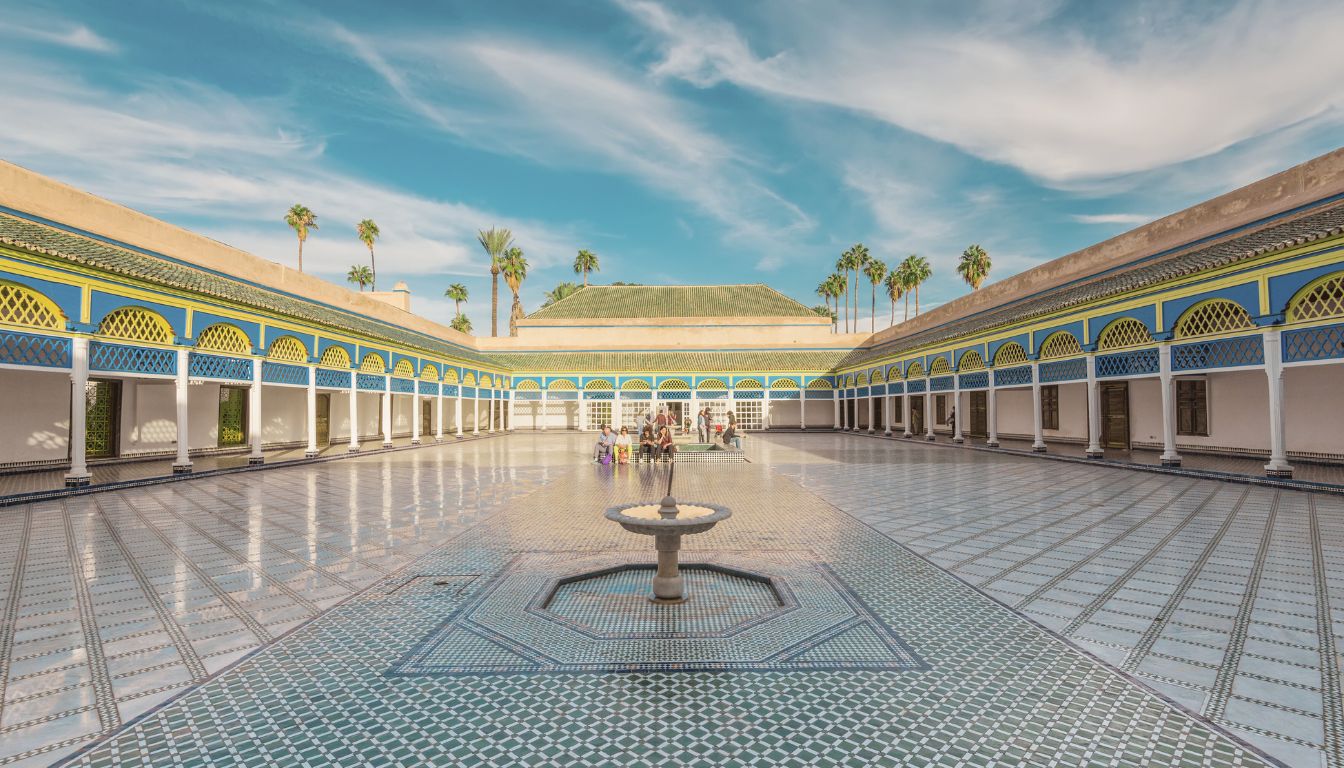
Bahia Palace Marrakech: History & Visitor Guide
The Bahia Palace in Marrakech is immense with nearly 150 rooms over eight hectares . It was built between 1866 and 1900 by Mohammed al-Makki. It is a fine example of Moroccan architecture , with a mixture of Moorish and Islamic style. Today, it is a museum that tells the history of the palace of Marrakech .
The Bahia Palace is in the medina of Marrakech . It attracts travelers from all over the world. They come to see its lush gardens and ornately decorated rooms . The design of the palace is made of mosaics, wooden sculptures and stained glass windows. This creates a unique ambiance, combining art with an exploration of Moroccan history.
The palace is easy to find thanks to its GPS coordinates : 31° 37′ 17″ north, 7° 58′ 54″ west . The curious can come and discover this 19th century architectural treasure. The visit is a history lesson and a true experience for the senses.
Introduction to the Bahia Palace Marrakech
The Bahia Palace Marrakech is a 19th century marvel. Although the royal family of Morocco now owns it, its history is rich. It perfectly represents Moroccan Islamic art and architecture.
It covers eight hectares and has around 150 luxuriously decorated rooms. It shows us an important aspect of Moroccan cultural heritage .
A 19th century marvel
The Bahia Palace Marrakech was designed by architect Mohammed al-Makki. It is a very fine example of Islamic architecture. Its construction began in 1866.
Under the direction of Si Moussa , it was partly built before being finished by Ba Ahmed , his son. It was he who added what we see today. The palace grew over time, offering extensive gardens, magnificent courtyards and exceptional art.
This palace is more than a work of art, it is a window into the past. You can see the Grand Riad, a huge space, but also the Aguedal orchard. It is a place open to the public, so everyone can discover this treasure of Moroccan heritage .
History of the Bahia Palace
The Bahia Palace in Marrakech is full of Moroccan history. With its eight hectares, it has around 150 rooms. It is a place witnessing wealth before colonization.
The beginnings under Si Moussa
In 1866, Si Moussa began building this palace. It was for Sultan Hassan I of Morocco. He wanted to build something big. Architect Mohammed al-Makki designed the structure. The work finished in 1867. They combined different architectural elements.
Expansion by Ba Ahmed
After Si Moussa , his son Ba Ahmed took over. Between 1894 and 1900 he expanded the palace. He added buildings, gardens and fountains. The palace became a place of luxury and beauty. He named the palace “Bahia” in honor of his favorite concubine. Thus, “Bahia” is synonymous with magnificence for the Bahia Palace .
The impressive architecture of the Bahia Palace
The Bahia Palace is a jewel of Moroccan architecture. It was built between 1880 and 1900. It shows the perfect blend of Moroccan and Islamic styles . Every detail testifies to work that combines tradition and novelty.
Use of Moroccan and Islamic styles
The architectural complexity of the palace is magnificent. Moroccan and Islamic styles shine there. One can see special courtyards and colorful zellige tiles. They show the exceptional know-how of the time. Wooden sculptures and zelliges add charm. The palace is a perfect balance of architecture through its different spaces.
Incorporation of stained glass
The palace early used stained glass windows. These colorful pieces were the first in the Maghreb region. They bring light and color to interiors. Wherever they are, they enrich the aesthetic appearance while respecting local traditions.
The gardens of the Bahia Palace
The Bahia Palace gardens are at the center of the site. They show the interesting combination of Arabic and European styles. These gardens extend over eight hectares, combining Mediterranean nature and Islamic designs.
There are orange trees, pomegranate trees, palm trees and rosemary trees. They create perfect corners to relax. The mosaics and fountains add to the beauty of this place.
The gardens are landscaped to bring calm and peace. They follow the style of the famous Islamic garden .
The Court of Honor: A jewel of the Palace
The Court of Honor of the Bahia Palace dazzles with its art and architecture. It is at the heart of the palace, immersing people in a world of Moroccan beauty.
It is covered in Carrara marble from Italy, adding a touch of luxury. This white marble contrasts with the colorful zellige mosaics. This clearly shows the refinement of Moroccan craftsmanship.
Paved with Carrara marble
600,000 visitors come to see it every year, making it the most popular place in Morocco. Its sober and serene beauty invites reflection in the heart of Marrakech.
The Harem of the Bahia Palace
The Bahia Palace Harem is in the center of the palace. It shows the interior architecture and social life of before. It was built between 1866 and 1900. It was for the wives and concubines of the vizier. Here, 24 concubines had their place. This place shares the opulence of royal family relationships.
Layout and Features
The Harem is large, with around 150 rooms on eight hectares. All rooms are beautifully decorated. There we find marble, moucharabiehs, paintings and zelliges. This shows the wealth and refinement of the time. The spaces have been designed to offer a luxurious living space to its inhabitants.
The Bahia Palace Harem immerses you in royal life. The rooms harmonize with the gardens and patios. These elements create a magical place. It is a perfect place to discover the beauty of this era.
Sightseeing visit to the Bahia Palace
The tourist visit to the Bahia Palace delves into the history of Marrakech. This impressive building was built in 1866. It took more than ten years to complete, and it covers an area of eight hectares.
It contains 150 rooms adorned with superb details. These details include stained glass windows, wooden sculptures, and flower paintings. You can visit this palace from 9 a.m. to 5 p.m. Thus, you will discover majestic rooms and lush gardens, full of orange trees, palm trees, and pomegranate trees.
Bahia Palace Tickets
Visiting this treasure of Marrakech heritage costs 70DH, approximately 7 euros. If you want a guide, you will have to add 100DH, 10 euros. For more peace of mind, try to be there before 9am. This way, you will avoid large crowds. Entrance is free for children under 12 years old.
Post-independence efforts
Since Morocco gained its independence, much has been done for the Bahia Palace . Efforts include consolidating structures and restoring decor. This work combines ancient know-how and modern methods to preserve history.
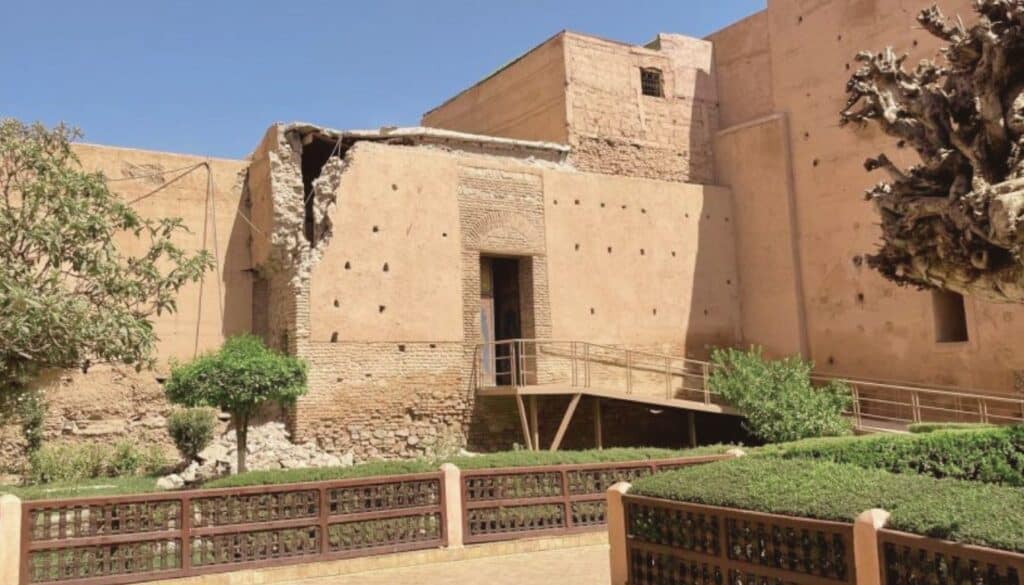
Impact of the 2023 earthquake
The 2023 earthquake seriously affected the Bahia Palace. After this disaster, immediate actions were necessary to stabilize the place. This reinforced the idea that constant restoration is essential for its long-term conservation .
The Beautifully Decorated Living Rooms
The salons of the Bahia Palace clearly display the art and architecture of Morocco. Their detailed decoration and majestic atmosphere capture everyone. Zouak craftsmanship, painting on wood, brings the ceilings and beams to life with its colors.
The Concubine Quarter
The Concubines Quarter is a special part of the Bahia Palace , in Marrakech. It shows how women lived in the 19th century, in a private corner of the large 8,000 m² palace. Twenty-four concubines resided there, enjoying luxury and comfort, with the riches of the palace all around.
Between 1866 and 1900, the Bahia Palace was built, under the direction of Si Moussa and his son. It is the current king of Morocco who has it. Every year, concerts and art exhibitions are organized there. The neighborhood stands out for its decorative details and quality materials. These features bear witness to the grandeur of the era of construction of the palace in Marrakech.
Today, those who visit the Concubine Quarter can see wonders. There are typically Moroccan and Muslim elements, finely crafted cedar wood ceilings, floors decorated with mosaics, and windows with iridescent Iraqi glass. This rare place illustrates the splendor of the Bahia Palace and the beauty of 19th century Moroccan craftsmanship.
Modern Use of the Bahia Palace
The Bahia Palace in Marrakech is a perfect example of mixing tradition and modernity. It remains an active royal residence . It is closed to visitors during royal family visits. But, it remains a source of culture and a key location for cultural events .
Royal residence and events
The Bahia Palace was for a long time the largest palace in Morocco. He is known for his exceptional concerts. Like the Sabah Zidani concert who sang classic Arabic songs by great artists.
The concerts make the Palais Royal a vibrant place of artistic creation. They blend the rich history of the palace with current culture.
The palace covers 80,000 m². This makes it perfect for hosting many cultural events . For example, the Artist’s Meeting shows artisans dedicated to Sufism and classical Arabic and Moroccan music.
This meeting is organized with the help of the Moroccan Ministry of Culture and Youth. It presents Andalusian music, malhoun and other forms of traditional music.
The Riad Principal and its Historical Importance
The iconic Riad Principal of the Palais de la Bahia in Marrakech showcases Moroccan architecture rich in history. Its construction began in 1866 and finished in 1900. This was under the supervision of Mohammed al-Makki. It covers 8,000 square meters on eight hectares, playing a major role in the history of the Bahia Palace .
This riad has 150 richly decorated rooms and magnificent patios. It clearly shows the elegance of Moroccan architecture and the talent of the artisans of the time. There are Andalusian and Moorish motifs. They blend well, creating a magical setting. A large Islamic garden and several interior courtyards bring peace. This creates a balance with the rich decorations.
Every part of the Riad Principal speaks of the history of the Bahia Palace . The initial plans by Si Moussa, the expansions by Ahmed ben Moussa tell the story. Over the centuries, it has become an important witness to Moroccan heritage . Today, this gem remains a special place. It shows the beauty of art and royal traditions of the 19th century to visitors.
Services and Equipment
Services at the Bahia Palace aim to make visitors’ stay in Marrakech memorable. The Bahia Palace is particularly appreciated for its warm welcome and high-quality services. It received an excellent rating, 9.1/10, from 177 reviews.
First of all, the free WiFi and the included tasty breakfast make the stay very comfortable. These services at Bahia Palace are ideal for families, groups of friends and couples.
The Palace also has modern facilities such as an outdoor swimming pool, a restaurant and a bar. Thus, it mixes history and modern luxury to offer a special experience. It is ideal for discovering Marrakech while appreciating its cultural heritage.
For adventurers, many tourist attractions are close to the Bahia Palace. Prices start at €98 per night and the average stay is three days. This way, travelers can enjoy a unique experience without spending too much, even during peak season.
Before booking, be sure to check the arrival, departure and cancellation rules for each room type. Consider visiting out of season to benefit from better rates. During peak periods, prices rise on average by 11%.
Access and Location
The Bahia Palace is in the center of Marrakech, easy to access. Every year, it receives around 600,000 curious visitors. They come to see its 160 beautiful rooms and large gardens. To get there, use these GPS coordinates : 31° 37′ 17″ North, 7° 58′ 54″ West. They will guide you to this jewel of Marrakech.
GPS coordinates
To get to the Bahia Palace, follow the numerous signs indicating the way. These instructions will help you avoid problems during your visit to the palace. Placed next to important sites, such as Jemaa el-Fnaa, the Palace is a place not to be missed.
By following these directions, your visit to the Bahia Palace will be well planned. Whether you come by car, on foot, or by public transport, you will arrive at this magnificent place. It is one of the most famous places in Marrakech.
Why is the Bahia Palace worth the visit?
The Bahia Palace in Marrakech is incredible to visit. It combines impressive architecture with rich history. It dates from the 19th century and covers eight hectares. You can admire 150 pieces with superb decorations.
The gardens are magnificent. They abound with banana and orange trees. Entrance costs around 7 euros. A guided tour is worth 10 euros more. Doors are open from 9 a.m. to 5 p.m. It is best to arrive early to avoid the crowds.
The Bahia Palace represents not only the architecture, but also the history of Marrakech. Its courtyard and splendid rooms impress. It is a place not to be missed when discovering Marrakech.
Conclusion
The Bahia Marrakech Palace shines in Moroccan heritage . Its construction began in 1866 under Si Moussa, the vizier of Sultan Hassan I. Then, his son Bou Ahmed continued the work. The Moroccan government bought it in the 1950s to preserve it.
People are amazed by zellige tiles. They cover floors, walls and ceilings, offering breathtaking views. The gardens, such as the Court of the Four Seasons and the Andalusian Garden, are impressive. For a peaceful visit, it is best to go there in the morning or evening.
Today, the palace covers eight hectares. It is open from 9 a.m. to 4:30 p.m., with a ticket at 70 Dh (7€) per person. It is an essential part of Moroccan culture. Additionally, it beautifully displays Islamic architectural art.
If the cultural visit intrigues you, the Palais Bahia Marrakech is ideal.

